Story and visual influences on The X-Files : Season 3
– Season 3 [1995-1996] –
3X01: The Blessing Way
– The Godfather (Francis Ford Coppola, 1972)
The Syndicate is introduced in this episode, a group of elderly well-dressed men meeting in a darkly lit room in New York. Just like the heads of the Five Families in the first “Godfather”. The “Godfather” films have been mentioned by Chris Carter and Frank Spotnitz as a significant narrative and cinematographical influence (and for who aren’t they?).
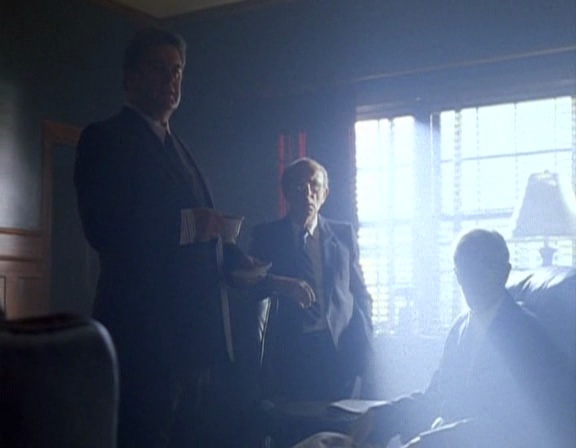 |
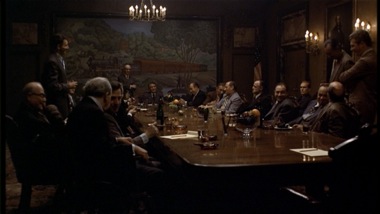 |
– The Boys from Brazil (Franklin J. Schaffner, 1978)
The Syndicate also brings to mind the team of Nazis that is responsible for the experiments and the executions in this film (film mentioned also in 1X10: Eve, 1X15: Young at Heart, …). Interestingly enough, one of the Nazis here is Walter Gottel, the actor who played Nazi doctor Victor Klemper in the next episode 3X02: Paper Clip.
 |
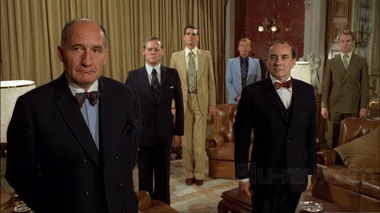 |
– Three Days of the Condor (Sydney Pollack, 1975)
One of the great conspiracy thrillers of the 1970s, with “All the President’s Men” it was certainly a big influence on Carter’s upbringing and political maturity and on the X-Files theme and tone specifically. The film deals with a CIA analyst who in his work discovers a plot involving his own organization; intrigue, betrayals and suspicion ensues.
More precisely, at one point the protagonist code-named “Condor” (Robert Redford) is warned by a hired assassin (Max Von Sydow) that he would better move because he risks being assassinated. The warning, coming from an aged apparently respectful man, is worded similarly to the warning the Well-Manicured Man (John Neville) gives to Scully in the episode.
In the film: “It will happen this way. You may be walking. Maybe the first sunny day of the spring. And a car will slow beside you, and a door will open, and someone you know, maybe even trust, will get out of the car. And he will smile, a becoming smile. But he will leave open the door of the car and offer to give you a lift.”
In the episode: “They’ll kill you one of two ways. They’ll send someone, possibly two men. They’ll kill you in your home or in the garage with an unregistered weapon which will be left at the scene. Using false documents supplied by associates of mine, they’ll be out of the country in less than two hours. […] He or she will be someone close to you. Someone you trust. They’ll arrange a meeting or come to your house unexpectedly.”
Additionally, the way Joubert describes the assassination in the film is the exact same way that Scully ends up suspecting will happen to her when at the end of the episode Skinner pulls over in front of her house, opens the door and invites her to get on.
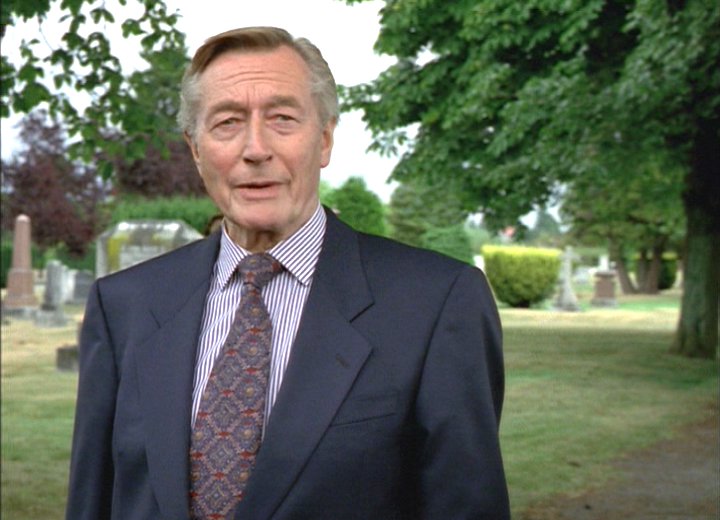 |
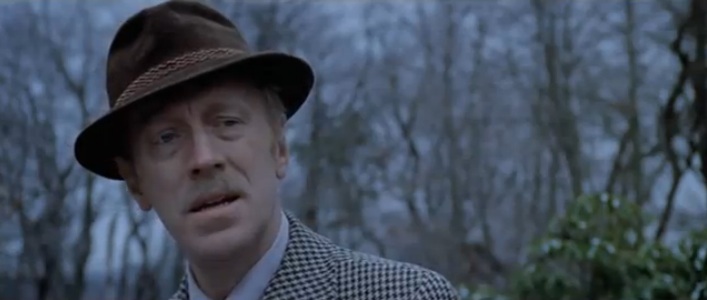 |
– Quatermass II (Nigel Kneale, 1955)
The “Quatermass II” BBC mini-series tells of an alien invasion (via small meteorites) that turns humans into aliens, without changing their appearance; the aliens then infiltrate the British Government, extend their influence to the Army, establish a plan of using industrial installations to grow their food and change the Earth’s atmosphere, and try to silence anyone opposing their plans. The Syndicate’s ties with Earth governments and its deal to “create the future” with an alien race was possibly inspired by “Quatermass” — the main difference being that the Syndicate’s members were always human. It was re-made by Hammer Films (in color) a few years later. See 1X08: Space, 7X03: The Sixth Extinction and 8X08: Per Manum for more “Quatermass” influences. “Quatermass” creator Nigel Kneale was asked to contribute to the X-Files in the 1990s but, as he also did with “Dr Who”, he declined.
– The Sleep of Reason Produces Monsters (Francisco Goya, 1799)
A possible inspiration for Deep Throat’s line “Do not look into the abyss or let the abyss look into you. Awaken the sleep of reason and fight the monsters within and without.” could be, unconsciously even, the inscription in Goya’s famous painting, a study of dreams, nightmares, imagination and creativity.
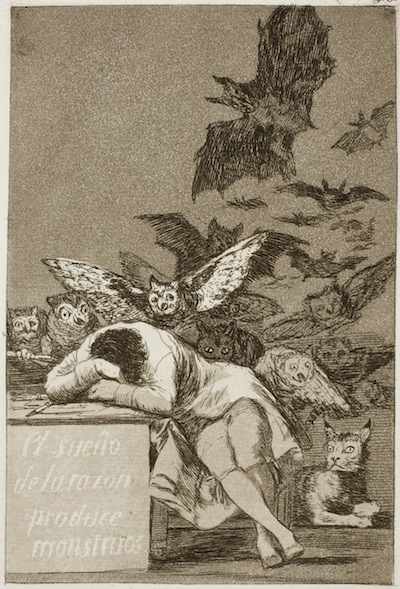
– Beyond Good and Evil (Friedrich Nietzsche, 1886)
Another inspiration for the same quote could be Nietzsche’s aphorism in his philosophical work: “He who fights with monsters should look to it that he himself does not become a monster. And when you gaze long into an abyss the abyss also gazes into you.”
3X02: Paper Clip
With the “Anasazi” three-parter, David Duchovny described the direction the mythology was taking, story-wise, as a mix of “Sophie’s Choice” and “Star Wars”.
– Sophie’s Choice (Alan J. Pakula, 1982)
Based on William Styron’s 1979 novel, this film presents survivors of Nazi concentration camps. It is revealed that one character, Sophie, had to make a choice between two unbearable options upon entering the concentration camp: choosing life or death for either of her two children. The term “Sophie’s choice” has now become a commonly used expression. This relates perfectly in the choice that it is revealed that Mulder’s mother had to make: choosing who would be abducted between her two children, Samantha or Fox.
– Star Wars Episode V: The Empire Strikes Back (Irvin Kershner, 1980)
In this trilogy, the X-Files move progressively away from a pure investigative show to a show that mixes elements of the protagonists’ lives in the fabric of the storytelling: scenes with their families, drama between protagonists and antagonists, personal alliances and betrayals, tensions and innuendos between family members. All these are part of a storytelling that belong more to the drama or soap opera genre, that the X-Files meticulously avoided in its first years in the way Mulder and Scully’s personal lives was limited to a strict minimum in order to focus on the case only. This dramatic storytelling would reinforce and become more important in the mythology, notably with 3X24: Talitha Cumi, culminating with the familial dynamics of Jeffrey/Mulder/CSM in season 5.
Duchovny’s comment must refer to the character drama in “The Empire Strikes Back” rather than to the straightforward adventure of “Episode IV: A New Hope”. The antagonist, Darth Vader, is revealed to be the father of the hero, putting the hero’s family in a central place in the story’s universe, similar to how Mulder’s father is revealed to be a central piece of the Syndicate mythos. Unresolved sexual tension between Han Solo and Leia and between Luke and Leia (revealed to be incestuous) make part of the drama, similar to the growing tension between Mulder and Scully.
– Close Encounters of the Third Kind (Steven Spielberg, 1977)
The cinematography used when Mulder witnesses the UFO emerging from behind the building and passing overhead is reminiscent, again, of “Close Encounters”: the darkness at first, the blinding emergence of the ship’s lights, the light/dark contrasts, the overexposure. Producer Paul Rabwin describes his thinking behind realizing the special effects for the episode in the making of featurette in the “Threads of Mythology” DVDs:
“The first time you ever really saw a spaceship on the show, how do you do it? Do you want to do it in your face or do you want to be a little more coy about it? And this dark mass starts appearing behind the building and Mulder looks up and sees this dark mass, and suddenly the brightness of it is so overwhelming that you can’t distinguish it that way – it’s like, it was so dark you can’t see it, and then suddenly it’s so bright that you can’t see it. And I thought that was absolutely brilliant, it was really the first time our mythology started to take on that kind of a science-fiction feel.”
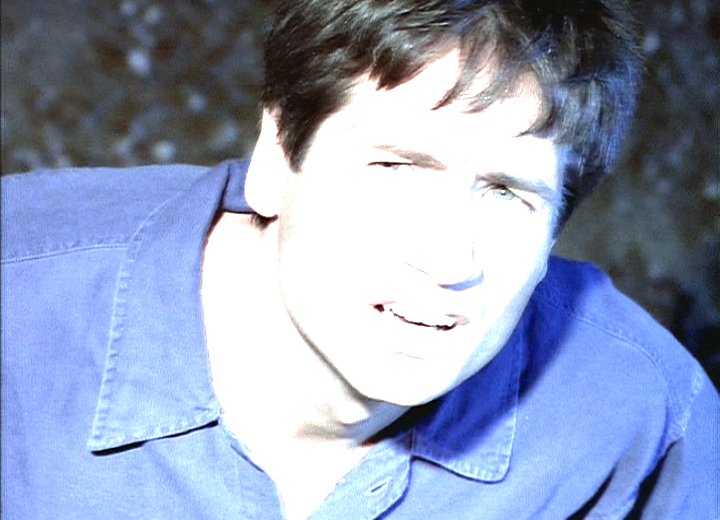 |
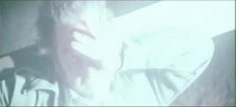 |
3X05: The List
– Shocker (Wes Craven, 1989)
Movie and episode share the plot of a serial killer who is executed on the electric chair and returns after death to carry out his vengeance. In the movie, he returns in the form of electricity or via electric-powered devices, unlike the apparition-themed episode. Funny trivia: the killer in the movie is portrayed by none other than Mitch Pileggi (Skinner).
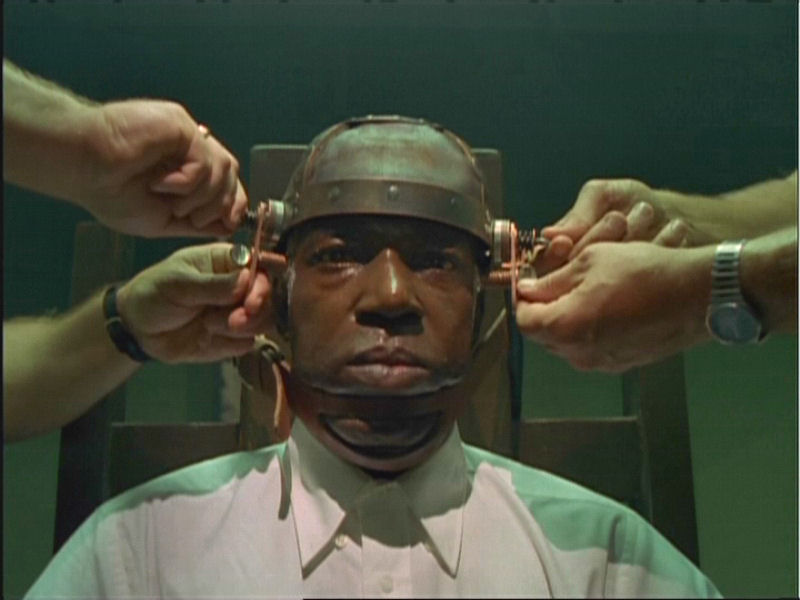 |
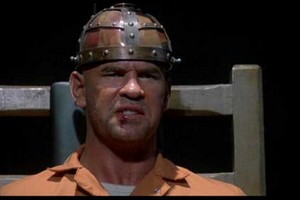 |
3X09: Nisei
– D.A.R.Y.L. (Simon Wincer, 1985)
The point-of-view angles, the medical equipment and the doctors in the examination scenes are very similar.
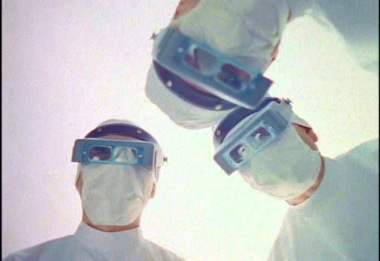 |
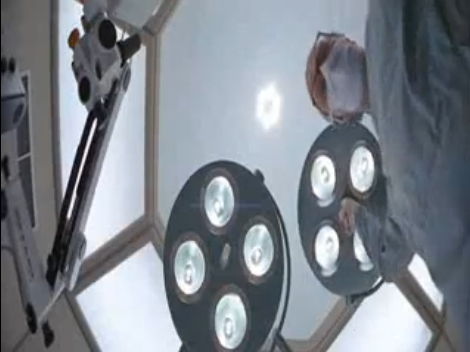 |
3X13: Syzygy
– Robocop (Paul Verhoeven, 1987)
In “Robocop”, a film that’s supposed to be entertainment and soothe the public is on every screen, all the time, its frantic laughs becoming a kind of background noise. In the episode, as part of the paranormal events that occur, the same film with a frantic comedy music keeps playing on every channel. Both in film and episode, the comedic films play as all hell breaks loose in the city.


The black-and-white clip that plays in Syzygy is from Keystone Cops (1912-1917), a series of short silent films featuring incompetent policemen in wild chases.
3X14: Grotesque
– House of Wax (André De Toth, 1953)
In the episode, the killer and apprentice artist hides the bodies of his victims in his statues, hidden by a layer of clay. This is similar to the horror film “House of Wax”, where it is revealed that an artist whose wax sculptures are appreciated as life-like actually uses dead bodies to create his figures. The movie was one of the first to be shot in 3D, which was hilghly popular in the 1950s-early 1960s.
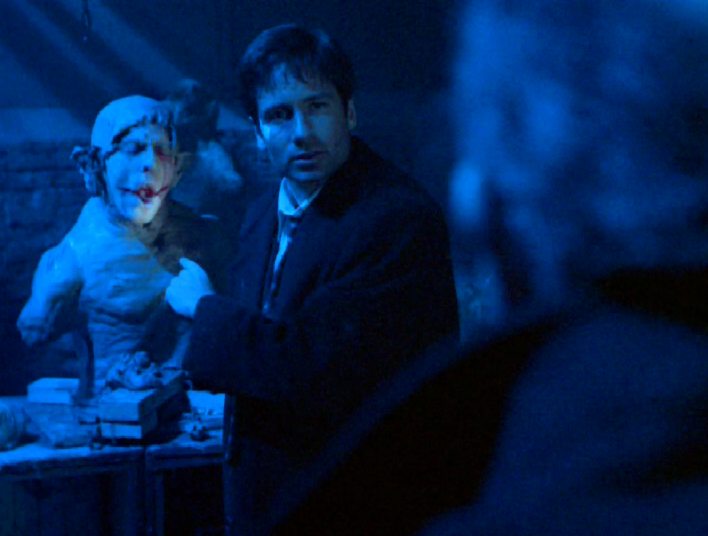 |
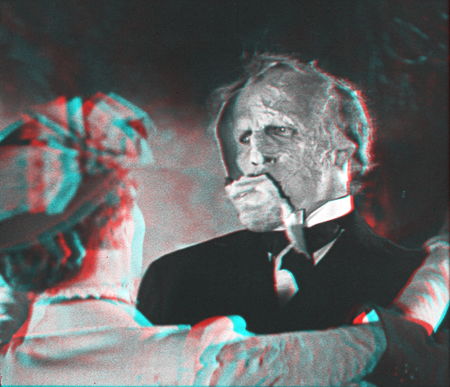 |
3X17: Pusher
– The Deer Hunter (Michael Cimino, 1978)
The episode culminates in a Russian roulette between Mulder and Modell (Robert Wisden). Perhaps cinema’s most famous Russian roulette scenes are found in “The Deer Hunter”, which deals with the psychological trauma of two Vitenam War vets (Christopher Walken, Robert De Niro). When they were prisoners of war, the soldiers were forced to play Russian roulette with each other; this will mark them for life, leading one of them to a suicidal fascination of roulette after the war.
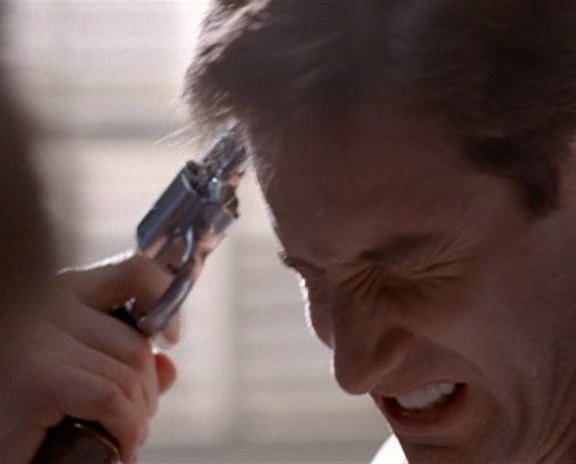 |
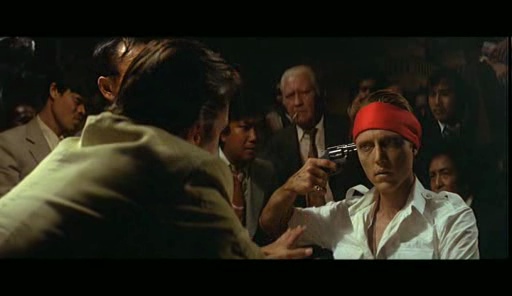 |
3X18: Teso dos Bichos
– The Mummy (Terence Fischer, 1959)
The episode is an X-Files take on the myth of the curse that strikes people that desecrate graves, in particular archeologists that desecrate ancestral burial grounds and do not respect the local culture that still considers these relics as holy, unleashing on them a revenge spell or curse as soon as they break open the tomb or vial in question. A well-known film version of this trope is Hammer Films’ “The Mummy”, which spawned several remakes.
3X20: José Chung’s From Outer Space
The whole episode is a collection of references and inter-textuality. Lots of homages in this episode that is parodic of many science fiction / UFO tropes.
– Pale Fire (Vladimir Nabokov, 1962)
The “other alien”, Lord Kinbote, takes its name from Charles Kinbote, the fictional narrator of Nabokov’s book, considered one of the writer’s best. “Pale Fire” is, like this episode, metafiction: a work that poses as describing one thing but ends up being more about the connections that the descriptions imply or wake up in the narrator or the reader, than the thing that is described itself. In the book’s case, it consists of a poem and commentary to that poem. In the episode, there is an event and the events and interpretations that occur and arise to understand this event.
The book is full of enigmas and references to other texts or people for the reader to find, very much like Jose Chung’s choice of subject matter or like Morgan’s episode as a whole.
It is by no coincidence that this episode is being studied as a pinnacle of post-modernism.
– The Mothman Prophecies (John A. Keel, 1975)
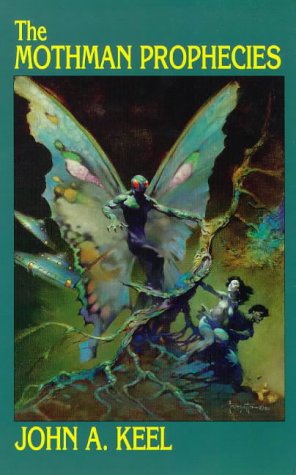
Weirdness abounds in this episode, and it could be said that the template for it was John Keel’s works of investigative journalism. His Fortean investigations in paranormal phenomena and his energetic and anxious and gonzo style of writing gave a feeling of fuzziness, of endless mysteries and weirdness wherever you look. With his most famous work, “The Mothman Prophecies”, he described the sightings of a winged supernatural being preceding a great catastrophe, and popularized the “Men In Black” as black-suited men sighted around UFO encounters. He came to believe that UFOs were not extraterrestrials visiting us, but rather “ultraterrestrians”. Roky’s experiences with the Man In Black, his writing his experiences, his later conversion as a guru on hollow Earth “lava men”, could be said to come from Keel. In fact, Jose Chung himself and the whole episode in the way it depicts the effects of a supernatural event on a small society could be said to encapsulate what reading “The Mothman Prophecies” feel like.There is even a specific scene lifted from the book. A young couple making out in a car have a weird encounter involving bright lights, then delay telling anyone about it because nobodyis supposed to know they were together. From the book:
Their first inclination was to run to the police but they decided against it, since they weren’t supposed to be on that road doing what they were doing in the first place. (“Her old man would’ve killed me!”)
The same scene takes place in the teaser and throughout the episode. The young man confesses: “If her father finds out, I’m a dead man.”
The Mothman entity itself is referenced by Mulder in 5X04: Detour.
– 20 Million Miles to Earth (Nathan Juran, 1957)
In the episode, the “inner Earth alien” Lord Kinbote was realized with stop-motion special effects, as opposed to “rubber suits” effects (like the white aliens) or more modern computer-generated (CGI) effects. The jagged, phony movements of Lord Kinbote are voluntary: this is a reference to old science fiction/fantasy films using the stop motion technique, which was one of the main special effects techniques from the birth of cinema to around the 1980s when CGI started replacing it. Stop-motion was made famous by special effects wizard Ray Harryhausen; several films were made as pure showcases of his monster and creature models. One typical example is the monster in “20 Million Miles to Earth”, but there are several: “The 7th Voyage of Sinbad” (1958), “Mysterious Island” (1961), “Jason and the Argonauts” (1963), “Clash of the Titans” (1981)… (see also 7X19: Hollywood A.D.).
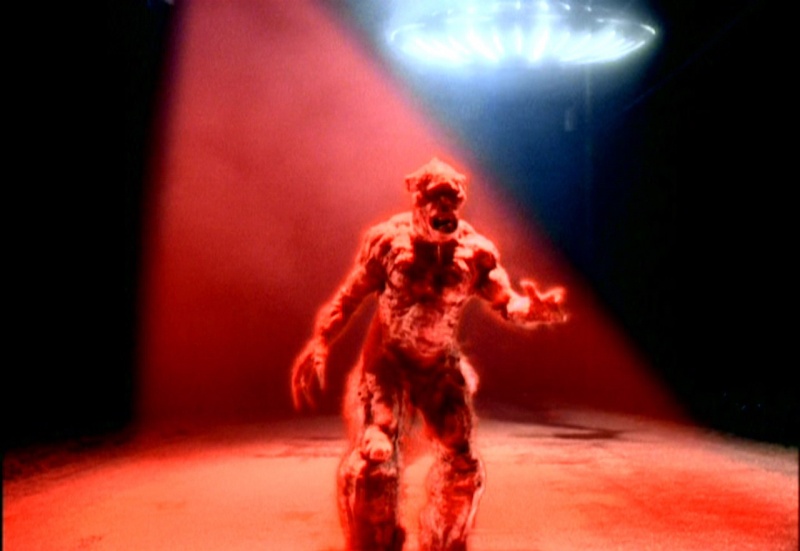 |
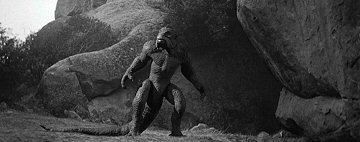 |
– Star Wars Episode Episode IV: A New Hope (George Lucas, 1977)
The opening shot of the episode is a reference to the opening shot of the first “Star Wars”: a low angle shot of a spaceship entering the frame from above, slowly gliding forward, the shot making evident the important size of the craft. The exact same setup is used in the episode, complete with what appears to be a triangular form of the craft, until it is revealed that this is not a craft at all but the below side of an electric crane lift.
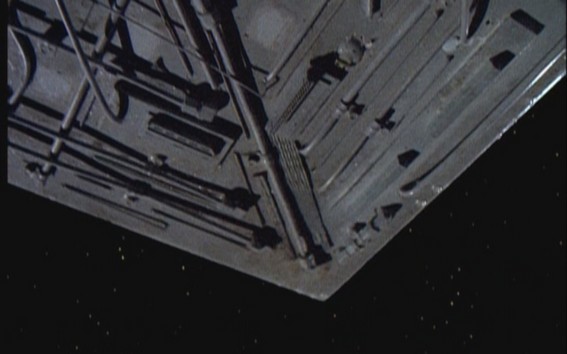 |
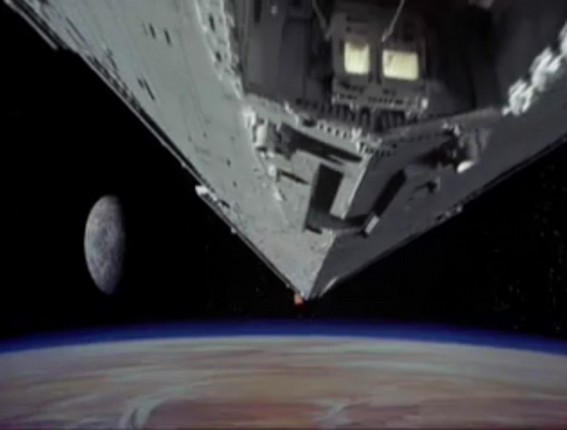 |
– Close Encounters of the Third Kind (Steven Spielberg, 1977)
The military pilot Mulder collects from the street is seen toying with his mashed potatoes in the diner: he forms a mound that he shapes with his fork. This is lifted from “Close Encounters”, where the main character is obsessed with a UFO encounter he’s had and has images of a shape of a mountain in his head; in a family dinner, he shapes his mashed potatoes like a mountain. The mountain turns out to be Devils Tower, with its characteristic shape, where the climactic close encounter occurs.
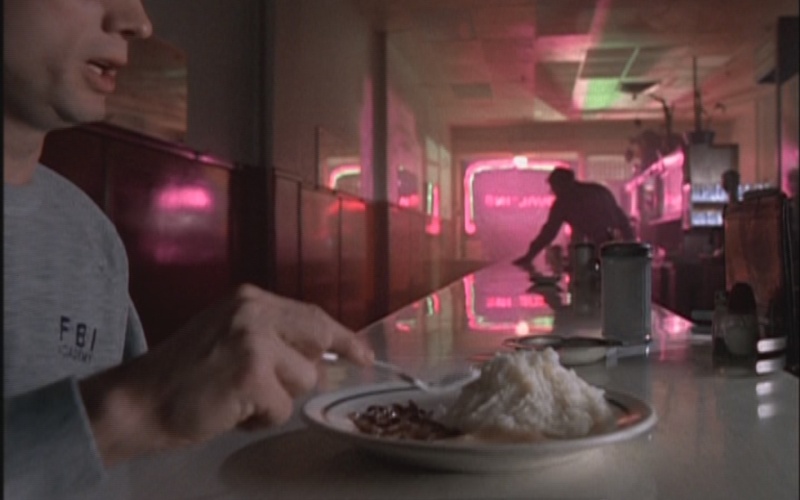 |
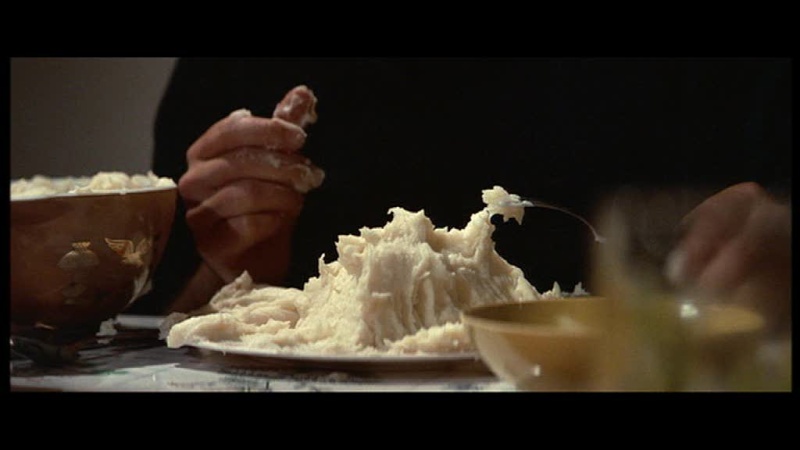 |
Roky is an electric company lineman and has a close encounter while at work at night. This is what happens to the protagonist of the movie Roy Neary played by Richard Dreyfuss.
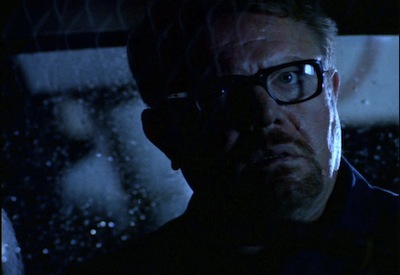 |
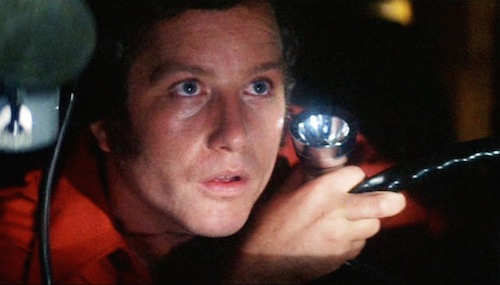 |
– Twin Peaks (David Lynch & Mark Frost, 1990-1991)
Mulder repeatedly enters the diner and orders a sweet potato pie. The setting (diner) and the pie is the same as in “Twin Peaks”, where characters are repeatedly seen to eat coffee (black) with a slice of cherry pie.
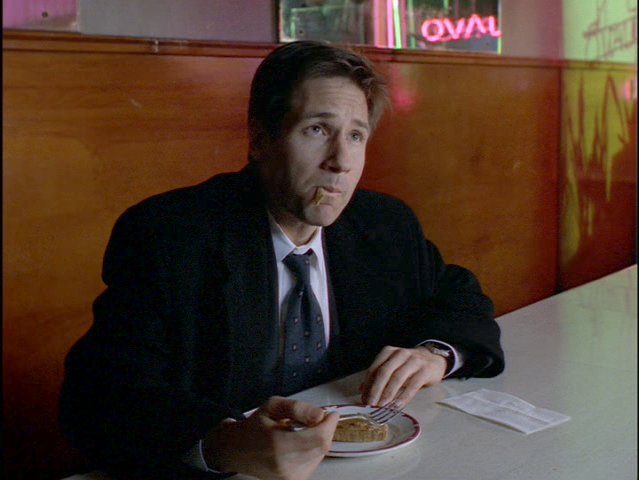 |
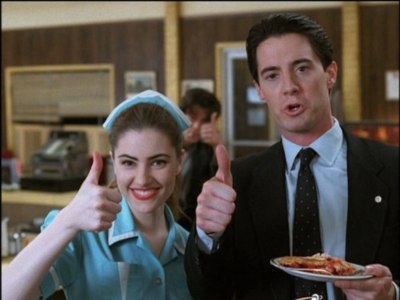 |
3X21: Avatar
– Don’t Look Now (Nicolas Roeg, 1973)
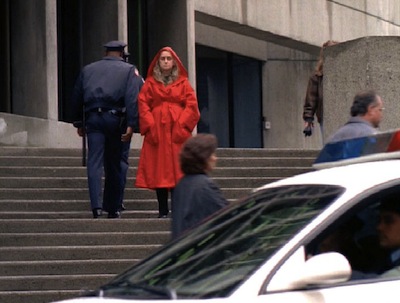 |
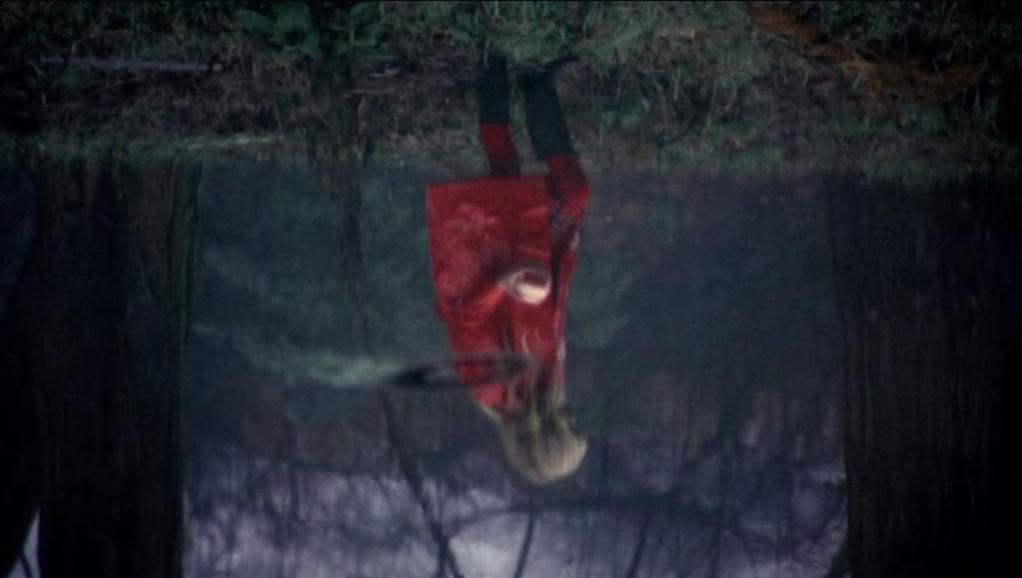 |
This influential moody thriller based on a short story by Daphne du Maurier, a married couple try to overcome the death of their daughter, by accidental drowning. The supernatural slowly enters their life, with visions of her death and visions of a girl running about, similarly dressed with a red raincoat. The twist ending involves a disfigured being and a serial killer.
The movie’s most characteristic visual — the vision of a person with a bright red overcoat — is incorporated in the episode — but so is the shift between beauty and disfigurement — like Skinner’s wife or the blonde prostitute transforms into the old succubus.
3X24: Talitha Cumi
– The Brothers Karamazov (Fyodor Dostoyevsky, 1880)
One of David Duchovny’s contributions in the Talitha Cumi script were explicit references to the long novel by Dostoyevsky, and more precisely to its best-known chapter in one of its twelve books (!): “The Grand Inquisitor”. It is a story-within-a-story of a debate between an Inquisitor of the Spanish Inquisition and an imprisoned Jesus on the question of free will that was given to Man; the Inquisitor considers it as a burden; Jesus is forgiving to the Inquisitor and the Inquisitor lets him leave the prison. The similarities with the two prison scenes between the Cigarette-Smoking Man/Inquisitor and Jeremiah Smith/Jesus are great, both in theme (free will, dominion of certain men over others, the value of religion and science in people’s lives), vocabulary (several old English terms are used, harkening back to the Bible) and tone.
Throughout the episode, the religious undertones surrounding Jeremiah are many: the healing hand, his well-meaning demeanor, his wording, his rebellion against oppressive forces, his Christian name and initials even (“JS” is often found in hero’s names, and could refer to “Jehovah-sammah”, i.e. “The Lord is here”, from Ezekiel 48:35).
The title of the episode itself, Talitha Cumi, is mentioned in the novel. It means “daughter, arise” in Aramaic, a phrase uttered by Jesus in a miracle when raising a girl from the dead (Mark 5:14); Jesus in the novel performs a similar miracle.
– The Invaders (Larry Cohen, 1967-1968)
The most obvious reference to the series is of course Roy Thinnes (the show’s only protagonist) guest starring in the episode. However, it’s also interesting that this occurs in the same episode when the mythology of the X-Files turns towards the colonization by aliens (not counting 2X16: Colony, which was really about a group of hybrids and could hardly be put on the same level as the Project introduced here), the same driving theme behind “The Invaders”.
– V (Kenneth Johnson, 1983) and V: The Final Battle (Richard T. Heffron, 1984)
In Talitha Cumi, the colonization theme for the mythology of the X-Files becomes evident. Alien colonization of Earth is a science fiction trope, however one of the hallmark uses of this theme immediately preceding the X-Files was “V”, the 1983 two-part mini-series, which was followed by a three-part mini-series wrapping up the story in 1984 and a full 19-episode TV series in 1984-1985. “V” features an alien invasion of Earth that at the beginning passes as a friendly cooperation initiative, but it is later revealed that the aliens’ real face is hidden behind a human-like mask (reminiscent of the shapeshifting Bounty Hunter here or the Rebels in 6X11: Two Fathers) and that the real plan is the extermination of the human species. Several parallels and references are made to real historical events mainly surrounding the Second World War, like in the X-Files: the Vichy government, collaborationists, an underground resistance, a Fifth Column, racial discrimination and extermination, racial purity…
– The Silence of the Lambs (Jonathan Demme, 1991)
The way Jeremiah Smith (Roy Thinnes) is tied up and carried to his cell is similar to the scene where Hannibal Lecter (Anthony Hopkins) is displayed in this movie, a recurring inspiration for the X-Files.
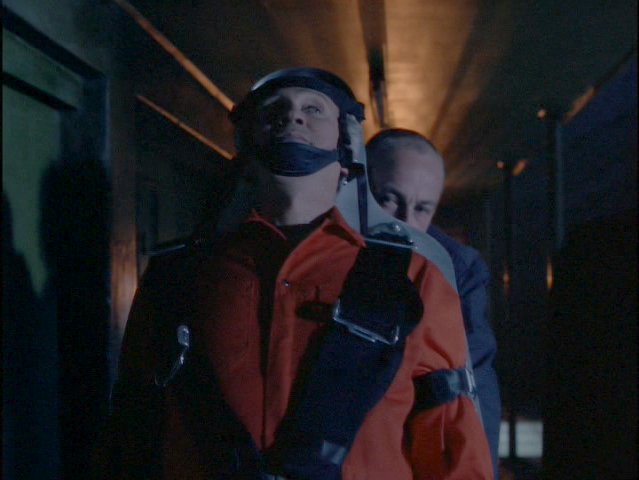 |
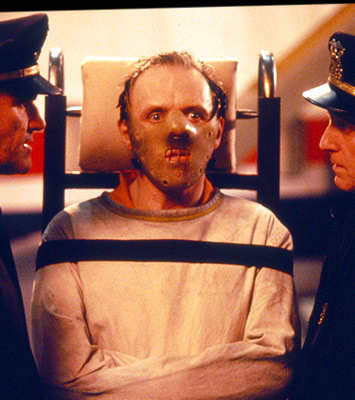 |
Really enjoying these lists. But, a nitpick on the Twin Peaks reference in Jose Chung – in the episode, Mulder only goes to the diner once to order multiple slices of pie. And the pie is sweet potato, not cherry.
Thanks — and correct about the pie. I guess it was not cherry in order to do two in one references, with Close Encounters right after this scene?
In Jose Chung… Mulder sits down at the lunch counter and winds up eating a whole ‘sweet potato pie’ in one sitting, NOT cherry pie. Y”a, I’ve watched this too many times…
Completely right, corrected!